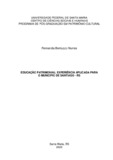| dc.creator | Nunes, Fernanda Bertazzo | |
| dc.date.accessioned | 2020-03-12T20:45:30Z | |
| dc.date.available | 2020-03-12T20:45:30Z | |
| dc.date.issued | 2020-01-06 | |
| dc.identifier.uri | http://repositorio.ufsm.br/handle/1/19830 | |
| dc.description.abstract | The work entitled “Heritage Education: an applied experience for the city of Santiago - RS” discusses heritage education as a possibility of educational action to be developed in schools, with the purpose of informing and making students aware of the value of preserving society's heritage and cultural assets. The focus of the research is the cultural heritage of Santiago, a city located in Rio Grande do Sul State, in Southern Brazil. The main objective is to propose heritage education actions as a way to promote and value heritage and to understand how students in a public school perceive the cultural heritage of their city. As a final product of the dissertation, the author elaborate an educational booklet: “A heritage tour through the city of Santiago” - later used in the classroom activity with students from the 4th grade of the São José Municipal Elementary School. Based on a theoretical reference and research on historical and tourist data of the city, this work sought to establish which places and buildings have the greatest historical and architectural interest in the history of Santiago, in order to understand their importance and their value through the heritage recognition that these places represent for the society. The exploratory qualitative methodology consists of bibliographic research and the creation of the educational booklet. Through illustrations and activities, the booklet explains the concepts of heritage through the cultural assets of Santiago. According to the experience carried out in the classroom, the research reinforces the importance that the material obtained as a complement in the education of students, having a positive result in view of the reaction that the children obtained with the handling and understanding of the educational booklet. | eng |
| dc.language | por | por |
| dc.publisher | Universidade Federal de Santa Maria | por |
| dc.rights | Attribution-NonCommercial-NoDerivatives 4.0 International | * |
| dc.rights.uri | http://creativecommons.org/licenses/by-nc-nd/4.0/ | * |
| dc.subject | Educação patrimonial | por |
| dc.subject | Santiago - RS | por |
| dc.subject | Cartilha | por |
| dc.subject | Patrimônio cultural | por |
| dc.subject | Heritage education | eng |
| dc.subject | Booklet | eng |
| dc.subject | Cultural heritage | eng |
| dc.title | Educação patrimonial: experiência aplicada para o município de Santiago - RS | por |
| dc.title.alternative | Heritage education: an applied experience for the city of Santiago - RS | eng |
| dc.type | Dissertação | por |
| dc.description.resumo | O presente trabalho, intitulado “Educação Patrimonial: experiência aplicada para o município de Santiago – RS”, discute a Educação Patrimonial como possibilidade de ação educativa a ser desenvolvida em escolas, com a finalidade de informar e conscientizar os estudantes acerca do valor da preservação dos bens patrimoniais e culturais da sociedade. O foco da pesquisa é o patrimônio cultural da cidade de Santiago, localizada no Rio Grande do Sul, Brasil. O objetivo geral é propor ações de Educação Patrimonial como forma de promover e valorizar o patrimônio e compreender como os alunos de uma escola pública do município percebem o patrimônio cultural de sua cidade. Como produto final da dissertação, elaborou-se a cartilha educacional “Um passeio patrimonial pela cidade de Santiago” – utilizada posteriormente na atividade em sala de aula. A atividade foi desenvolvida com estudantes do 4º ano da Escola Municipal de Ensino Fundamental São José. A partir de embasamento teórico e pesquisa sobre dados históricos e turísticos do município, buscou-se estabelecer quais lugares e edificações possuem maior interesse histórico e arquitetônico na história de Santiago, a fim de compreender sua importância e seu valor pelo reconhecimento patrimonial que esses lugares representam para a sociedade. A metodologia, de caráter qualitativo exploratório, baseou-se em pesquisas bibliográficas e na criação da cartilha educacional. Por meio de ilustrações e atividades, a cartilha explica os conceitos de patrimônio através dos bens culturais do município. De acordo com a experiência realizada em sala de aula, reforça-se a importância que o material obteve como complemento na educação dos alunos, tendo um resultado positivo diante da reação que as crianças obtiveram com o manuseio e entendimento da cartilha educacional. | por |
| dc.contributor.advisor1 | Ribeiro, Marcelo | |
| dc.contributor.advisor1Lattes | http://lattes.cnpq.br/6668223529036644 | por |
| dc.contributor.referee1 | Ceretta, Caroline Ciliane | |
| dc.contributor.referee1Lattes | http://lattes.cnpq.br/4388433550209518 | por |
| dc.contributor.referee2 | Pons, Mônica Elisa Dias | |
| dc.contributor.referee2Lattes | http://lattes.cnpq.br/1266730315285809 | por |
| dc.creator.Lattes | http://lattes.cnpq.br/4957906937388105 | por |
| dc.publisher.country | Brasil | por |
| dc.publisher.department | História | por |
| dc.publisher.initials | UFSM | por |
| dc.publisher.program | Programa de Pós-Graduação em Patrimônio Cultural | por |
| dc.subject.cnpq | CNPQ::CIENCIAS HUMANAS::HISTORIA | por |
| dc.publisher.unidade | Centro de Ciências Sociais e Humanas | por |



